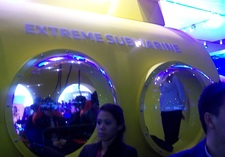
“Pretty soon we’re going to live in a world where everyone has the power to share and experience whole scenes as if you’re just there, right there in person”
This was Mark Zuckerberg, at last month’s Mobile World Congress (MWC 2016), explaining why Facebook is investing so much in virtual reality technology. Or at least, I’m told these were his words because although I was at the Barcelona Congress, like most attendees, I couldn’t actually afford the 2,000€-plus special pass to see him in person.
This was Mark Zuckerberg, at last month’s Mobile World Congress (MWC 2016), explaining why Facebook is investing so much in virtual reality technology. Or at least, I’m told these were his words because although I was at the Barcelona Congress, like most attendees, I couldn’t actually afford the 2,000€-plus special pass to see him in person.
However, the fact that hundreds of other attendees - or at least their companies - were willing to stump up the cash suggests that, when it comes to communication, the “real” still trumps the “virtual”.
| Indeed, although 2016 is supposed to be the year that computer-simulated reality finally arrives, the very modus operandi of tech shows like Barcelona’s MWC seems to suggest exactly the opposite. And not just in the main conference hall. After all, in theory, the over 100,000 Congress attendees could have all stayed home, experienced the demos from the comfort of their sofa and placed their orders online. |
Instead, here they all were wandering around an exhibition space the size of 15 football pitches, touching, feeling and trying out the new products and services. Just like the world outside, an awful lot of buying, selling and browsing was going on in a physical location.

Gaming and other entertainment will probably be the first application of this new VR technology but even here there are technical challenges to overcome. I say this because the most popular virtual reality exhibits in Barcelona included a heavy dose of distinctly non-virtual mechanisation.
| South Korea's SK Telecom offered a virtual reality ride under water in a yellow submarine and Samsung’s Gear Theatre put audiences through a virtual rollercoaster-ride with the aid of special VR headsets. But in both cases participants could only get the full sensation of motion and and changing speed by sitting in moving seats. |
Old fashioned non-virtual showmanship was also much in evidence. Live presenters with headset microphones and
| smooth sales patters did much of the convincing when it came to demonstrating the new devices. This was probably just as well because the mechanical element of many of the VR demos - from bicycle pedals to movable ski platforms - had broken by the third day of the Congress. In his presentation, Zuckerburg also spoke effusively about the benefits of virtual reality for business communication, “Imagine holding a group meeting or event anywhere in the world that you want” he told his audience. “All these things are going to be possible.” |
For the sake of the planet, I hope he’s right because according to the organisers 40% of MWC attendees come from outside Europe and that’s the equivalent carbon footprint of 80 fully-loaded 747s.
| Perhaps one day the events like the Mobile World Congress will simply become an online virtual experience but a quick look round me suggested that isn’t happening anytime soon. What were all these business executives and tech professionals doing? Well, meeting and greeting each other in various trendy roof-top bars, sharing a coffee with each other or rather more irritatingly indulging in some very stationary networking on the moving walkways. Let alone |
taking part in virtual meetings, I didn’t even see many people on Skype (probably because the Congress’s Wi-fi service was abysmal).
No doubt virtual reality has amazing potential but it doesn’t just face technical challenges. It will surely take some time before the human brain itself fully embraces this brave new world of simulated physical intimacy.
No doubt virtual reality has amazing potential but it doesn’t just face technical challenges. It will surely take some time before the human brain itself fully embraces this brave new world of simulated physical intimacy.






 Canal RSS
Canal RSS
